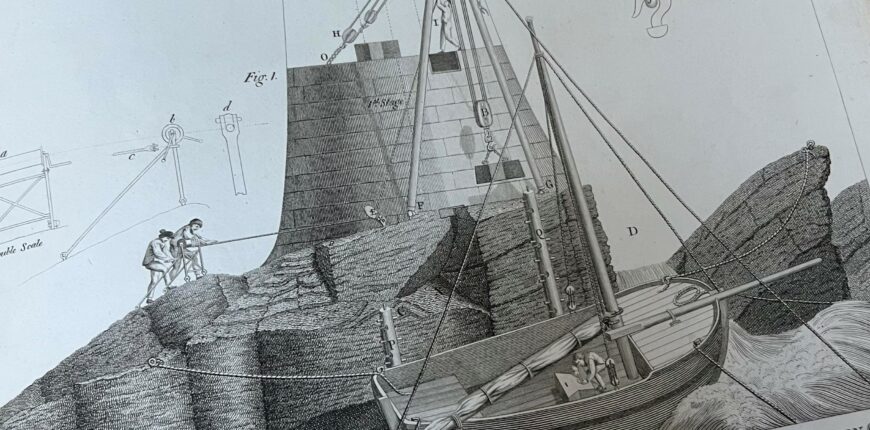John Smeaton (1724-1792)

Narrative of the building and a description of the construction of the Edystone lighthouse with stone (1813)
 Smeaton spent his early working years making scientific instruments and developed a practical interest in the mechanics of water and windmills. In 1753, at the age of 29, he was invited by Lord Cavendish to become a Fellow of the Royal Society. There he made the professional contacts and gained the reputation that led to the invitation to design and construct a new lighthouse on the treacherous Eddystone Rock (probably his first major “civil” engineering project). The name of this rock is believed to derive from the associated eddy currents that are created in the surrounding sea.
Smeaton spent his early working years making scientific instruments and developed a practical interest in the mechanics of water and windmills. In 1753, at the age of 29, he was invited by Lord Cavendish to become a Fellow of the Royal Society. There he made the professional contacts and gained the reputation that led to the invitation to design and construct a new lighthouse on the treacherous Eddystone Rock (probably his first major “civil” engineering project). The name of this rock is believed to derive from the associated eddy currents that are created in the surrounding sea.
By any standards Smeaton’s lighthouse was a very successful construction, completed in 1759, and lasting in service for about 120 years. Smeaton went on to design mills, canals, harbours, bridges etc., and cofounded the Society of Civil Engineers (which started as a fortnightly dining club), the precursor of the present-day Institution of Civil Engineers founded in 1818.
Smeaton was asked by Trinity House to write an account of the construction of the lighthouse ‘so that in the event of the destruction of the present edifice, they could discover the errors and imperfections’. This took some 35 years, with the first edition being published in 1791 – A Narrative of the Building and a Description of the Construction of the Edystone Lighthouse.
As he admits in the book, Smeaton was much more at home with mechanics and practical design and construction than with writing:
‘I have it not in my power to present … a fine piece of writing, or of drawing; neither literature, not the fine arts, having been much the objects of my study; but I humbly submit … a plain account of the construction of a plain and simple building, that has nevertheless been acknowledged to be, in itself, curious, difficult, and useful; and as such, I trust, worthy of observation.’
The first print run soon proved to be inadequate for the demand, and a second printing appeared in 1793, the year after Smeaton’s death. The Devon and Exeter Institution has the 1813 edition.
Smeaton’s book includes descriptions of two preceding lighthouses designed by Henry Winstanley (1644-1703) and John Rudyerd (1650-c. 1718). Smeaton spent over three years designing and constructing his lighthouse and describes it in detail in the form of an engineer’s logbook. Innovative features of his lighthouse included:
- The tapered shape – to provide stability and reduce wind loads;
- Dovetailed masonry and the development of a hydraulic cement that would set under water;
- Prestressing with iron bars around the circumference, said to be inspired by Wren’s design of St Paul’s Cathedral.

